Shaking Table Test Research on Novel Frame Structures: A Review
Abstract
1. Introduction
2. Scaling Theory for Frame Structures
2.1. Calculation Methods for Similarity Relationships
| Methods for Similarity Relationships | Advantages | Disadvantages |
|---|---|---|
| Analytical method | The similarity accuracy of the model is the highest. | Complex equations and many unknowns |
| Dimensional analysis method | It ensures the similarity accuracy of the main parameters of the model and reduces the difficulty of analysis. | It cannot provide accurate results. |
| Extended dimensional analysis method | The accuracy of similarity is higher than the dimensional analysis method. | Its analysis is more difficult than dimensional analysis. |
2.2. Design Methods for Similarity Ratios
3. Selection of Seismic Excitation Inputs
4. Shaking Table Tests of Novel Frame Structures
4.1. Shaking Table Tests of RC Frame Structures
4.2. Shaking Table Tests of Steel Frame Structures
4.3. Shaking Table Tests of Steel–Concrete Composite Frame Structures
4.4. Shaking Table Tests of External Dampers and Self-Centering Frame Structures
5. Conclusions
- The flexible form of frame structures makes it difficult to develop a unified test design method for shaking table tests. To accommodate specific test requirements and structural forms, a reasonable test design method must be selected from various similarity calculation methods and similarity rate design approaches. A highly flexible dimensional analysis method is suggested to determine the similarity relationships for the test. By disregarding less significant errors, the accuracy of critical parameter data can be ensured, leading to positive results in the testing process. Full-scale models provide the highest degree of similarity and can accurately simulate the dynamic characteristics of prototype structures under seismic action. Therefore, full-scale models are preferable when conditions allow for them. However, when conditions are constrained, particularly for high-rise buildings or structures sensitive to vertical loads, stress similarity should be prioritized. For low-rise frame structures, an equivalent density similarity design can be adopted to achieve a more precise simulation of the horizontal stress state.
- The input seismic waves should be selected from a seismic wave database that aligns with the site category and design seismic group specifications of the building location. This ensures that the selected seismic waves accurately reflect the actual conditions. Additionally, based on the specific objectives of the shaking table test, such as assessing seismic performance or evaluating seismic responses, additional appropriate seismic waves should be identified. By selecting suitable actual strong-motion earthquake records and artificially synthesized seismic waves, as well as adhering to specific selection procedures and considerations, the precision and effectiveness of the test results can be ensured.
- Incorporating innovative materials, advanced reinforcement techniques, and sophisticated seismic protection measures can significantly enhance the seismic performance of RC frame structures under extreme earthquake conditions. These measures reduce structural damage and improve structural failure mechanisms. During low-intensity earthquakes, torsional effects can induce substantial damage to non-structural components. However, during high-intensity earthquakes, the impact of torsion on structural damage is minimal. As earthquake intensity increases, structural damage accumulates progressively, as evidenced by reductions in the higher-order vibration mode frequencies and modal shape amplitudes. Infill walls substantially augment the initial stiffness and lateral strength of RC frame structures. Nevertheless, as cumulative damage occurs, the stiffness of frame structures degrades. Infill walls can considerably enhance the safety of RC frame structures during major earthquakes. However, infill walls with openings are more susceptible to collapse than solid walls. Advanced concrete materials can significantly reduce structural damage, enhancing the structure’s deformability, energy-dissipation capabilities, and stiffness degradation rate.
- Considering the inherent material properties of steel, steel frame structures typically exhibit significant dynamic responses during earthquakes. Despite experiencing plastic deformation, these structures maintain residual load-bearing capacity and demonstrate excellent ductility. In shaking table tests, damage to steel frame structures is often concentrated at connections. The configuration of connections considerably influences the seismic response of frame structures under actual earthquake conditions. Generally, steel connections outperform RC connections during earthquakes, and steel-connected frame structures demonstrate superior ductility. Integrating supplementary components, such as bracing and infill walls, can significantly augment the stiffness and damping characteristics of steel frame structures. These components reduce the seismic response, mitigate damage at connections, and act as a primary line of defense during extreme earthquakes. By sustaining damage before the main frame, they effectively protect the primary structure.
- Steel–concrete composite frame structures combine the distinctive attributes of both RC and steel structures, offering a diverse range of configurations with enhanced seismic resistance. The seismic performance of these composite structures is influenced by a multitude of factors, including the cross-sectional dimensions of steel and concrete components, as well as connection methodologies. These factors can be systematically evaluated through shaking table tests to assess their impacts on structural seismic performance. Composite structures incorporating steel sections and steel pipes with concrete typically exhibit a beam–hinge failure mechanism that aligns with the seismic design principle of strong columns and weak beams. Structural damage predominantly manifests as the initiation and propagation of concrete cracks within beams and columns; progressive yielding of flanges, webs, and longitudinal reinforcement at the beam ends of the steel sections; and bond–slip effects between the steel and concrete interfaces. As the structure transitions into the plastic stage, the base shear force initially increases rapidly and then gradually, forming complete hysteresis loops, indicative of a robust energy-dissipation capacity. In mixed-frame structures with varying structural configurations across different floors, the characteristic site period exerts the most significant influence on the peak acceleration response.
- The flexible design of external dampers can be more effectively integrated within frame structures to mitigate seismic risks. Among these dampers, seismic isolation dampers are particularly complex to design but are essential for protecting the upper structure and reducing seismic impact on the overall structure. In contrast, energy-dissipation dampers primarily protect the main structure by enhancing the energy-dissipation capacity of the frame, thereby reducing structural displacement and acceleration responses. Furthermore, under rare earthquakes, imparting a self-centering capability to frame structures is crucial for maintaining their integrity and functionality. This capability significantly diminishes post-seismic deformation and expedites rapid functionality restoration.
Author Contributions
Funding
Conflicts of Interest
References
- Savoia, M.; Buratti, N.; Vincenzi, L. Damage and collapses in industrial precast buildings after the 2012 Emilia earthquake. Eng. Struct. 2017, 137, 162–180. [Google Scholar] [CrossRef]
- Li, N.; Zhu, B.; Zhang, L. Damage analysis of a pseudoclassic reinforced concrete frame structure under the action of the M s 6.8 Luding earthquake in China. Structures 2024, 60, 105887. [Google Scholar]
- Wang, J.; Zhao, J.D.; Hu, Z.Y. Review and thinking on development of building industrialization in China. China Civ. Eng. J. 2016, 49, 1–8. (In Chinese) [Google Scholar]
- Zhang, J.X.; Ding, C.; Rong, X.; Yang, H.W.; Li, Y.Y. Development and experimental investigation of hybrid precast concrete beam–column joints. Eng. Struct. 2020, 219, 110922. [Google Scholar]
- Zhang, J.X.; Ding, C.; Rong, X.; Yang, H.W.; Wang, K.; Zhang, B. Experimental seismic study of precast hybrid SFC/RC beam–column connections with different connection details. Eng. Struct. 2020, 208, 110295. [Google Scholar]
- Lu, X.; Fu, G.; Shi, W.; Lu, W. Shake table model testing and its application. Struct. Des. Tall Spec. Build. 2008, 17, 181–201. [Google Scholar] [CrossRef]
- Xu, Z.D. Review for dynamic researches in civil engineering in recent years. Sci. China Tech. Sci. 2010, 535, 1450–1452. [Google Scholar]
- Zhou, Y.; Lu, X.L. Method and Technology for Shaking Table Model Test of Building Structures; Beijing Science Press: Beijing, China, 2012. (In Chinese) [Google Scholar]
- Wang, J.; Yin, J.; Li, X.; Yi, J.; Wang, Z. Construction of Scaled Model of Reinforced Concrete Column Based on Dimensional Analysis. Acta Armamentarii 2023, 44, 189–195. (In Chinese) [Google Scholar]
- Zhang, M.Z. Application of similarity laws in seismic simulation experiments: Several issues. Earthq. Eng. Eng. Vib. 1997, 17, 199–208. (In Chinese) [Google Scholar]
- Fu, H.R.; Cao, Y.T.; Qu, Z. Substructural shake table testing for nonstructural elements of various damage sensitivity in a fixed-base and a base-isolated building. Eng. Struct. 2024, 321, 119017. [Google Scholar] [CrossRef]
- Li, P.; Liu, Y.; Zhou, K.; Zhu, S.; Li, Y. Review of similar design of shaking table model tests. J. Inst. Disaster Prev. 2020, 22, 29–35. (In Chinese) [Google Scholar]
- Huang, S.; Guo, X.; Zhang, M.; Meng, Q.; Zhang, H. Study of design method and similitude for small-scale reinforced concrete structural models. Chin. Civ. Eng. J. 2012, 45, 31–38. (In Chinese) [Google Scholar]
- Huang, S.; Guo, X.; Meng, Q.; Liu, H. Classified similarity relationships of medium-to-small scale models for the single-particle system in earthquake simulation experiments. J. Basic. Sci. Eng. 2013, 21, 71–77. (In Chinese) [Google Scholar]
- Cheng, S.G.; Yang, X.; Zhu, Y.X.; Zhang, W.P. Study on simulation law of shaking table test based on equivalent yield strength coefficient. Earthq. Eng. Eng. Dyn. 2020, 40, 1–10. (In Chinese) [Google Scholar]
- Lin, G.; Zhu, T.; Lin, B. Similarity technique for dynamic structural model test. J. Dalian Univ. Technol. 2000, 40, 1–8. (In Chinese) [Google Scholar]
- Chi, S.C.; Lam, S.S. Validation of similitude laws for dynamic structural model test. World Earthq. Eng. 2004, 20, 11–20. (In Chinese) [Google Scholar]
- Darli, C.M.; Tang, A.P.; Huang, D.L.; Zhang, J.Q. Large scale shaking table model test and analysis on seismic response of utility tunnel in non-homogeneous soil. Earthq. Eng. Eng. Vibra 2021, 20, 505–515. [Google Scholar]
- Choi, I.K.; Kyu, K.M.; Choun, Y.; Seo, J.M. Shaking Table Test of Steel Frame Structures Subjected to Scenario Earthquakes. Nucl. Eng. Technol. 2005, 37, 191–200. [Google Scholar]
- Qiu, D.P.; Chen, J.Y.; Xu, Q. Dynamic responses and damage forms analysis of underground large scale frame structures under oblique SV seismic waves. Soil Dyn. Earthq. Eng. 2019, 117, 216–220. [Google Scholar]
- Shimada, Y.; Takahashi, K.; Yamada, S. Collapse Behavior of Reduced-Scale Frames by the Inverted Shaking Table Method under Dynamic Seismic Loading. Int. J. Steel Struct. 2022, 22, 1798–1807. [Google Scholar]
- Zuo, Z.; Gong, M.; Sun, J. Seismic performance of RC frames with different column-to-beam flexural strength ratios under the excitation of pulse-like and non-pulse-like ground motion. Bull Earthq. Eng. 2021, 19, 5139–5159. [Google Scholar] [CrossRef]
- Sun, L.; Bai, Y.; Lai, Z. Shaking table test on seismic performance of a large-span high-rise building. Sci. Rep. 2024, 14, 6580. [Google Scholar] [CrossRef] [PubMed]
- Fan, Y.L.; Song, J.Y.; Zhou, X.L.; Liu, H. Seismic Performance Evaluation of a Frame System Strengthened with External Self-Centering Components. Buildings 2024, 14, 3666. [Google Scholar] [CrossRef]
- Velasco, M.A.P.; Dela Cruz, O.G.; Guades, E.J. Reinforced Concrete Beam–Column Joint: A Review of Its Cyclic Behavior. Adv. Civ. Eng. Mater 2023, 310, 63–79. [Google Scholar]
- Helal, Y.; Garcia, R.; Imjai, T. Seismic behaviour of Exterior RC beam-column joints repaired and strengthened using post-tensioned metal straps. Bull Earthq. Eng. 2024, 22, 3261–3286. [Google Scholar]
- Vibhute, A.; Bharti, S.D.; Shrimali, M.K.; Tolani, S. Seismic Performance Evaluation of Base Isolated Building Frame with LRB Under the Action of Mainshock and Aftershock. Recent Dev. Struct. Eng. 2024, 2, 101–109. [Google Scholar]
- Khalil, A.; Minjuan, H.; Wael, A. Enhancing seismic performance of structures: A comprehensive review of hybrid passive energy dissipation devices. Structures 2024, 69, 107223. [Google Scholar]
- Benavent-Climent, A.; Morillas, L.; Escolano-Margarit, D. Inelastic torsional seismic response of nominally symmetric reinforced concrete frame structures: Shaking table tests. Eng. Struct. 2014, 80, 109–117. [Google Scholar]
- Sun, K.; Cheng, S.G.; Zhu, Y.X. Dynamic property and acceleration response of shaking table test about existing RC frame structures. Eng. Mech. 2020, 37, 229–236. (In Chinese) [Google Scholar]
- Zhou, Y.; Feng, J.; Cai, J.; Cao, Y.; Zhang, Q. Shaking table test on a frame structure model of SCOPE system. J. Build. Struct. 2022, 43, 100–110. (In Chinese) [Google Scholar]
- Tang, Y.; Li, Y.; Liu, L.; Jiang, B.; Yu, H.; Ji, S. Shaking table test of an RC frame structure with different cross-section columns of stilted floor. J. Vib. Shock. 2023, 42, 1–27. (In Chinese) [Google Scholar]
- Xiao, S.; Zhou, G.; Feng, P.; Qu, Z. Seismic performance evaluation of novel RC frame structure with kinked rebar beams and post-yield hardening columns through shaking table tests. Eng. Struct. 2023, 290, 116375. [Google Scholar]
- Zhao, B.; Yi, J.; Li, X.; Tian, Y.; Lu, X. Experimental recognition of seismic performance of simple bolt-connected precast frame by comparing with equal stiffness cast-in-situ frame. J. Build. Eng. 2023, 78, 107689. [Google Scholar] [CrossRef]
- Pang, R.; Sun, Y.; Xu, Z.; Gao, C.; Yang, J.; Zhang, P. Shaking table test of structure with discretely connected precast RC diaphragm. J. Build. Struct. 2023, 44, 125–137. (In Chinese) [Google Scholar]
- Stavridis, A.; Koutromanos, I.; Shing, P.B. Shake-table tests of a three-story reinforced concrete frame with masonry infill walls. Earthq. Engng Struct. Dyn. 2012, 414, 1089–1108. [Google Scholar]
- Benavent-Climent, A.; Ramírez-Márquez, A.; Pujol, S. Seismic strengthening of low-rise reinforced concrete frame structures with masonry infill walls: Shaking-table test. Eng. Struct. 2018, 165, 142–151. [Google Scholar] [CrossRef]
- Zhao, L.; Wang, X.; Huang, D.; Gong, E. Shaking table comparison tests of frame structure with fabricated straw brick infilled wall. Build. Struct. 2019, 49, 48–51. (In Chinese) [Google Scholar]
- Xiao, J.; Pham, T.L.; Ding, T. Shake Table Test on Seismic Response of a Precast Frame with Recycled Aggregate Concrete. Adv. Struct. Eng. 2015, 189, 1517–1534. [Google Scholar] [CrossRef]
- Hou, S.; Zhang, H.; Han, X.; Ou, J. Damage monitoring of the RC frame shaking table test and comparison with FEM results. Procedia Eng. 2017, 210, 393–400. [Google Scholar]
- Xu, L.; Pan, J.; Leung, C.K.Y.; Yin, W. Shaking table tests on precast reinforced concrete and engineered cementitious composite/reinforced concrete composite frames. Adv. Struct. Eng. 2018, 21, 824–837. [Google Scholar]
- Khan, I.; Shahzada, K.; Bibi, T.; Ahmed, A.; Ullah, H. Seismic performance evaluation of crumb rubber concrete frame structure using shake table test. Structures 2021, 30, 41–49. [Google Scholar] [CrossRef]
- Wang, D.Y.; Wang, Z.Y.; Yu, T.; Li, H. Shake Table Tests of Large-Scale Substandard RCFrames Retrofitted with CFRPWraps before Earthquakes. J. Compos. Constr. 2017, 21, 04016062. [Google Scholar] [CrossRef]
- Li, S.; Zuo, Z.; Zhai, C.; Xuc, S.; Xie, L. Shaking table test on the collapse process of a three-story reinforced concrete frame structure. Eng. Struct. 2016, 118, 156–166. [Google Scholar] [CrossRef]
- Luo, H.; Du, K.; Sun, J.; Xu, W.; Ding, B. Shaking table test on complete collapse process of RC frame structure subjected to earthquake. J. Build. Struct. 2017, 38, 49–56. (In Chinese) [Google Scholar]
- Morita, K.; Teshigawara, M.; Hamamoto, T. Detection and estimation of damage to steel frames through shaking table tests. Struct. Control Health Monit. 2005, 12, 357–380. [Google Scholar]
- Kim, S.E.; Lee, D.H.; Ngo-Huu, C.N. Shaking table tests of a two-story unbraced steel frame. J. Constr. Steel Res. 2007, 63, 412–421. [Google Scholar]
- Saranik, M.; Lenoir, D.; Jézéquel, L. Shaking table test and numerical damage behaviour analysis of a steel portal frame with bolted connections. Comput. Struct. 2012, 112–113, 327–341. [Google Scholar]
- Zhang, Z.; Cao, W.; Liu, Y.; Liu, Z.; Wang, R. Shaking table test on prefabricated light steel frame with light steel truss structure. J. Harbin Inst. Technol. 2019, 51, 67–75. (In Chinese) [Google Scholar]
- Chung, Y.L.; Nagae, T.; Matsumiya, T.; Nakashima, M. Seismic resistance capacity of beam-column connections in high-rise buildings: E-Defense shaking table test. Earthq. Engng Struct. Dyn. 2011, 40, 605–622. [Google Scholar]
- Ji, X.; Fenves, G.L.; Kajiwara, K.; Nakashima, M. Seismic Damage Detection of a Full-Scale Shaking Table Test Structure. J. Struct. Eng. 2011, 1371, 14–21. [Google Scholar]
- Zhang, A.; Xie, Z.; Zhang, Y.; Lin, H. Shaking table test of a prefabricated steel frame structure with all-bolted connections. Eng. Struct. 2021, 248, 113273. [Google Scholar] [CrossRef]
- Cabaleiro, M.; Moutinho, C.; González-Gaya, C.; Caetano, E.; Rosales-Prieto, V.F. Analysis of Stiffness of Clamped Joints versus Bolted Joints in Steel Structures by Means of Accelerometers and Shaking Table Tests. Sensors 2021, 2114, 4778. [Google Scholar] [CrossRef]
- Li, J.; Wang, Y.; Zhang, Z.; Mou, B. Seismic behavior of steel frames with different joints: Shaking table test and finite element analysis. J. Build. Eng. 2023, 70, 106377. [Google Scholar]
- Yu, H.; Zhang, W.; Zhang, Y.; Sun, Y. Shaking table test and numerical analysis of a 1:12 scale model of a special concentrically braced steel frame with pinned connections. Earthq. Eng. Eng. Vib. 2010, 91, 1–16. [Google Scholar]
- Dong, Z.; Li, G.; Liu, Y.; Li, H. Shaking table test on low-ductility concentrically braced steel frames. J. Build. Struct. 2020, 41, 21–29. (In Chinese) [Google Scholar]
- Du, D.; Wang, S.; Li, W.; Xu, F.; Liu, W. Seismic Performance of the Pre-Fabricated Steel Frame Infilled with AAC Wall Panels and their Joint Connection: Full-Scale Shaking Table Test. J. Earthq. Tsunami 2019, 13, 1940004. [Google Scholar]
- Rao, Y.; Chen, Y.; Geng, L.; Lin, Q. Shaking table study on a full scale model of prefabricated ECP steel frame building. Sichuan Build. Sci. 2019, 45, 30–36. (In Chinese) [Google Scholar]
- Zhang, Z.; Cao, W.; Wang, R.; Hou, J.; Chen, Y.; Li, D. Shaking table test on prefabricated steel frame structure with ribbed thin walls. J. Harbin Inst. Technol. 2020, 52, 10–19. (In Chinese) [Google Scholar]
- Zhao, H.L.; Ye, Z.M. Progress in seismic behaviors of the composite steel-concrete structures. Mech. Eng. 2014, 36, 1–8. [Google Scholar]
- Benavent-Climent, A.; Escolano-Margarit, D. Shaking table tests of structures with hysteretic dampers: Experimental results versus prediction using non-linear static methods. Bull. Earthq. Eng. 2012, 10, 1857–1883. [Google Scholar] [CrossRef]
- Xue, J.; Zhou, C.; Liu, Z.; Hu, Z. Experimental study on seismic response of steel reinforced concrete spatial frame with special-shaped columns. Chin. Civ. Eng. J. 2017, 50, 88–104. (In Chinese) [Google Scholar]
- Liu, Z.; Yang, X.; Xue, J.; Zhou, C. Shaking table test and numerical simulation on steel reinforced concrete frame with special-shaped columns. J. Vib. Eng. 2019, 32, 17. (In Chinese) [Google Scholar]
- Li, Z.; Xu, S.; Liu, H.; Jiao, A. Shake table test on a new type of precast CFST column-RC beam braced frame structure. Chin. Civ. Eng. J. 2016, 49, 22–30. (In Chinese) [Google Scholar]
- Zhang, Z.; Dong, H.; Cao, W.; Liu, Y.; Ye, T. Full-scale shaking table test of prefabricated CFSST column frames-strip composite wall structure. J. Build. Struct. 2021, 42, 25–34. (In Chinese) [Google Scholar]
- Lu, Z.; Li, J.; Zhou, Y. Shaking table test and numerical simulation on a vertical hybrid structure under seismic excitation. Struct. Design Tall Spec. Build. 2018, 27, e1497. [Google Scholar] [CrossRef]
- Zhao, Y.; Bai, Y.; Bo, W. Shaking table test research on a new type of prefabricated light gauge steel hybrid structure. Steel Constr. 2019, 34, 31–38. (In Chinese) [Google Scholar]
- Zheng, J.; Song, W.; Lei, Y.; Wang, T. Shaking table test study on friction-pendulum isolated frame structures. China Civil. Eng. J. 2020, 53 (Suppl. S2), 240–246. (In Chinese) [Google Scholar]
- Guerrero, H.; Ji, T.; Escobar, J.A.; Teran-Gilmore, A. Effects of Buckling-Restrained Braces on reinforced concrete precast models subjected to shaking table excitation. Eng. Struct. 2018, 163, 294–310. [Google Scholar] [CrossRef]
- Xin, R.; Zhang, Q.; Huang, W.; Bi, D. Shaking table test of large-space RC frame reinforced by viscous dampers. J. Build. Struct. 2023, 44, 20–30. (In Chinese) [Google Scholar]
- Yang, H.; Li, Z.; Wang, H.; Zhang, M.; Ni, S. Shaking table test study on seismic performance of RC frame structure with NES. Structures 2023, 47, 153–164. [Google Scholar] [CrossRef]
- Lu, X.; Cui, Y.; Liu, J.; Gao, W. Shaking table test and numerical simulation of a 1/2-scale self-centering reinforced concrete frame. Earthq. Engng Struct. Dyn. 2015, 4410, 1497–1514. [Google Scholar]
- Cui, Y.; Lu, X.; Jiang, C. Experimental investigation of tri-axial self-centering reinforced concrete frame structures through shaking table tests. Eng. Struct. 2017, 132, 684–694. [Google Scholar] [CrossRef]
- Li, X.; Zhang, F.; Wang, Z.; Tian, K.; Dong, J.; Jiang, L. Shaking table test of a frame structure retrofitted by externally-hung rocking wall with SMA and disc spring self-centering devices. Eng. Struct. 2021, 240, 112422. [Google Scholar]
- Lu, L.; Ye, Y.; Xia, W.; Huang, Z. Study on the seismic performance of a 3D external prestressed self-centering reinforced concrete frame by shaking table test. China Civ. Eng. J. 2020, 53 (Suppl. S2), 68–73. (In Chinese) [Google Scholar]
- Lu, L.; Yan, H.; Xia, W.; Tan, Y. Shaking table test of RC frame structure with energy dissipating self-centering hinge joint. J. Build. Struct. 2022, 43 (Suppl. S1), 53–60. (In Chinese) [Google Scholar]
- Masnata, C.; Adam, C.; Pirrotta, A. Optimal design of short-period structures equipped with sliding tuned liquid column damper and numerical and experimental control performance evaluation. Acta Mech. 2024, 235, 1603–1622. [Google Scholar] [CrossRef]
- Masnata, C.; Pirrotta, A. Optimal control of base-isolated systems with sliding TLCD under stochastic process. Eng. Struct. 2024, 318, 118754. [Google Scholar]
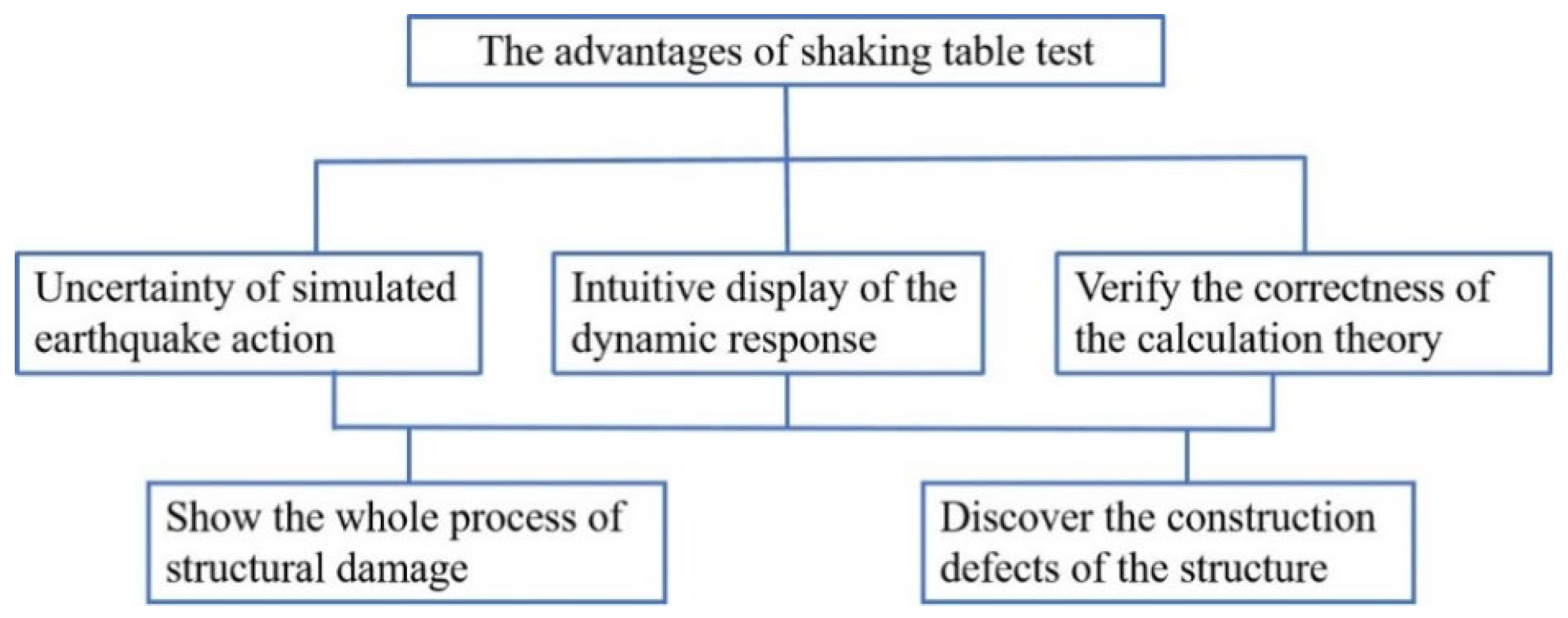
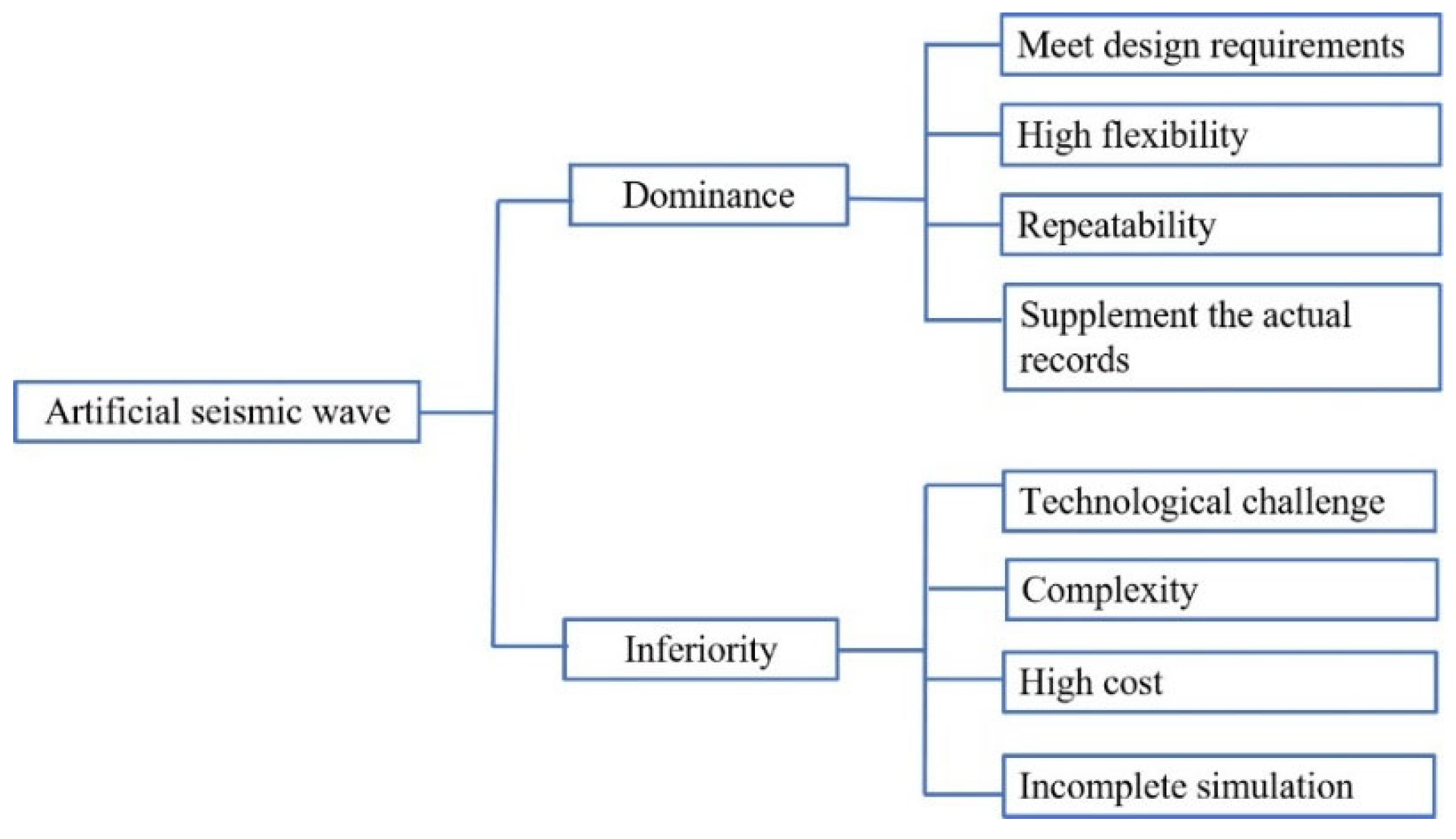

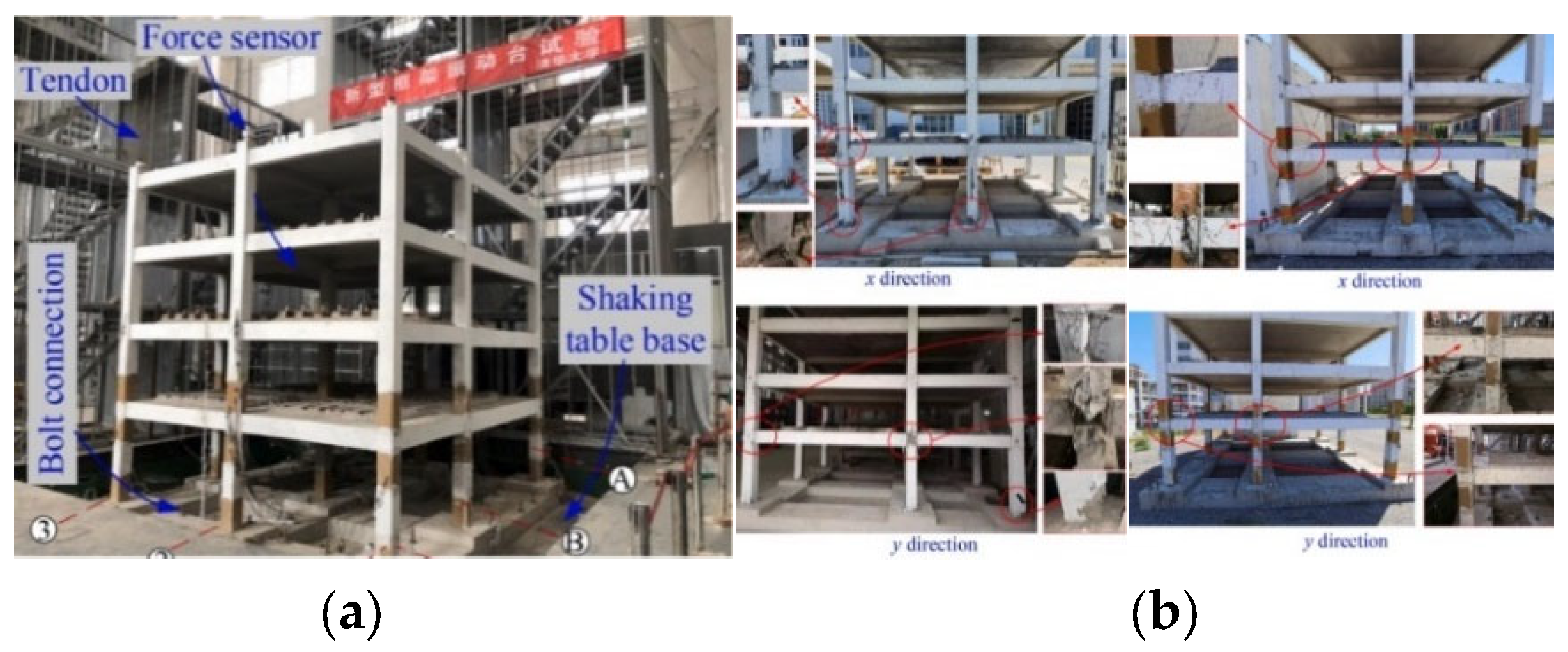
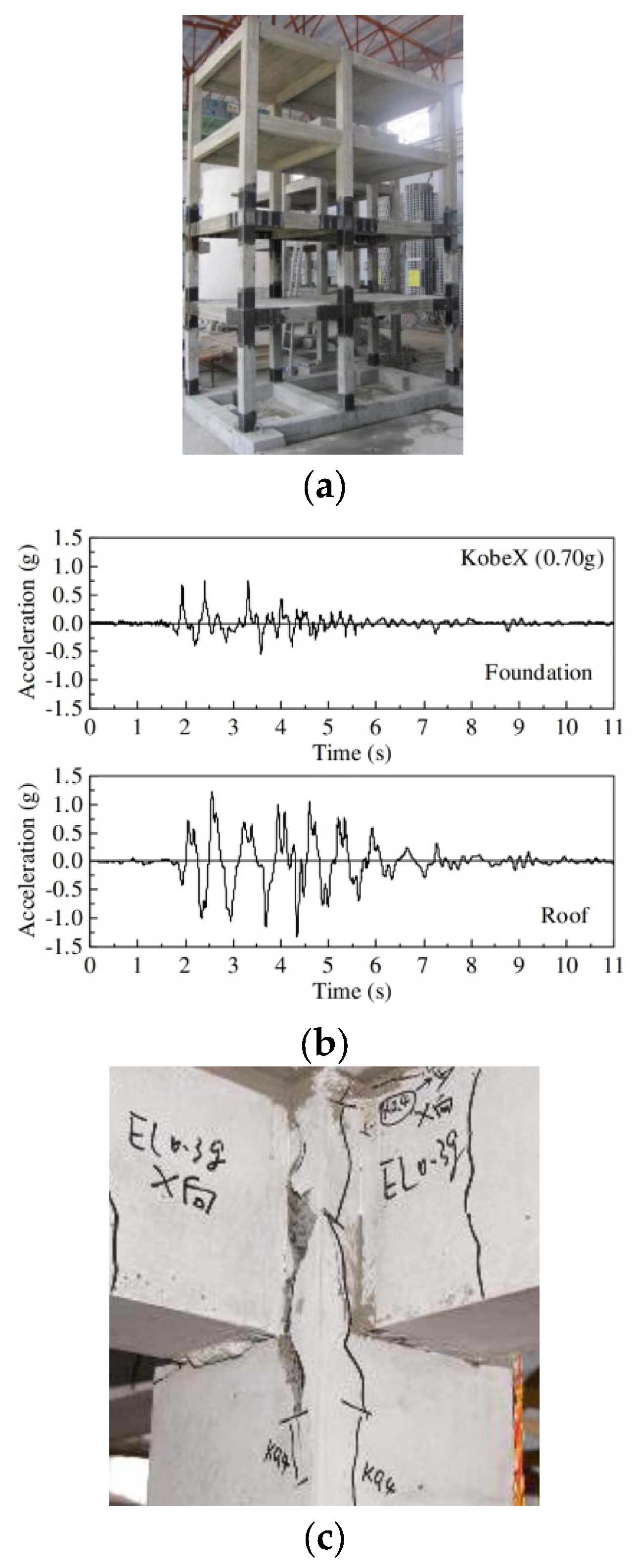
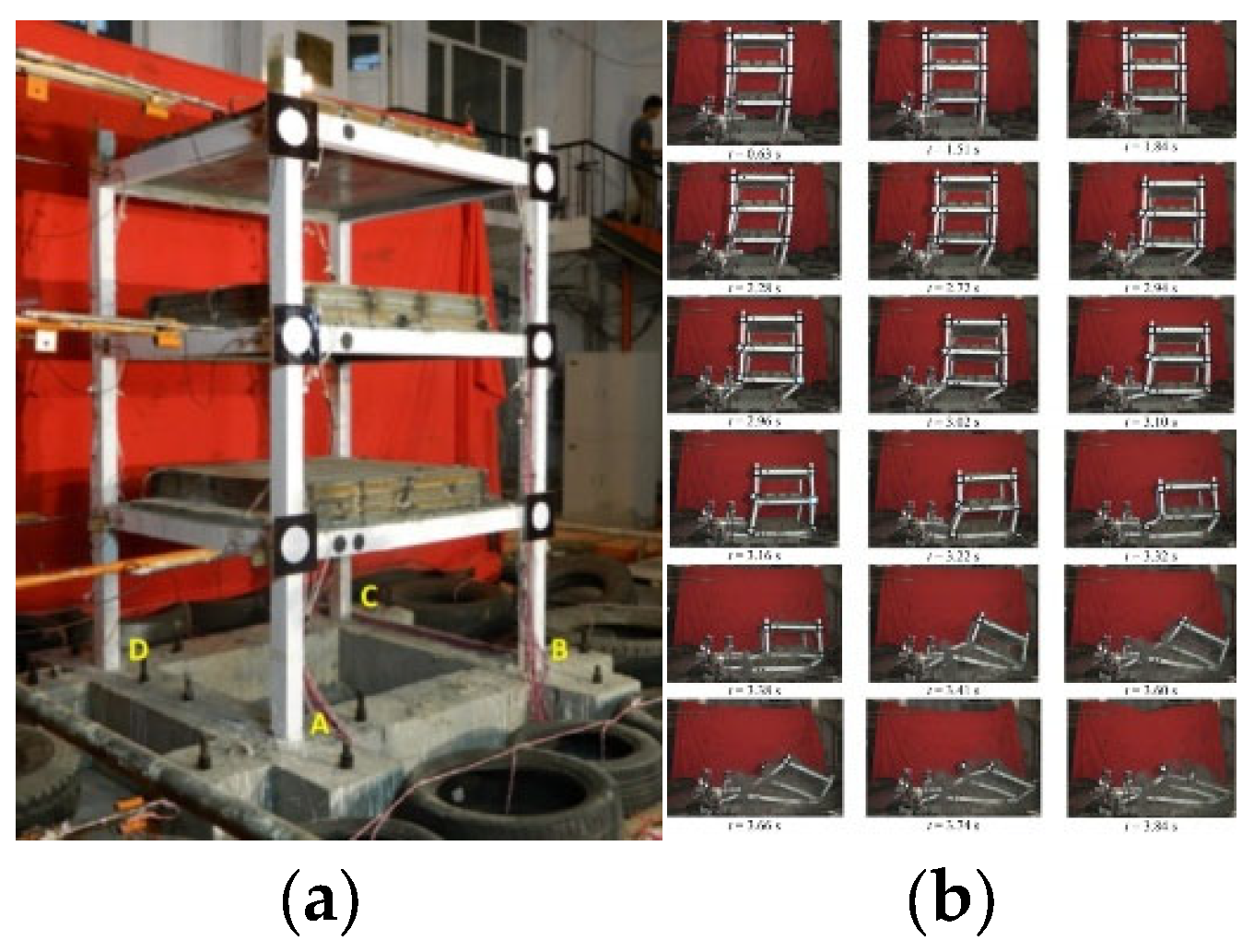
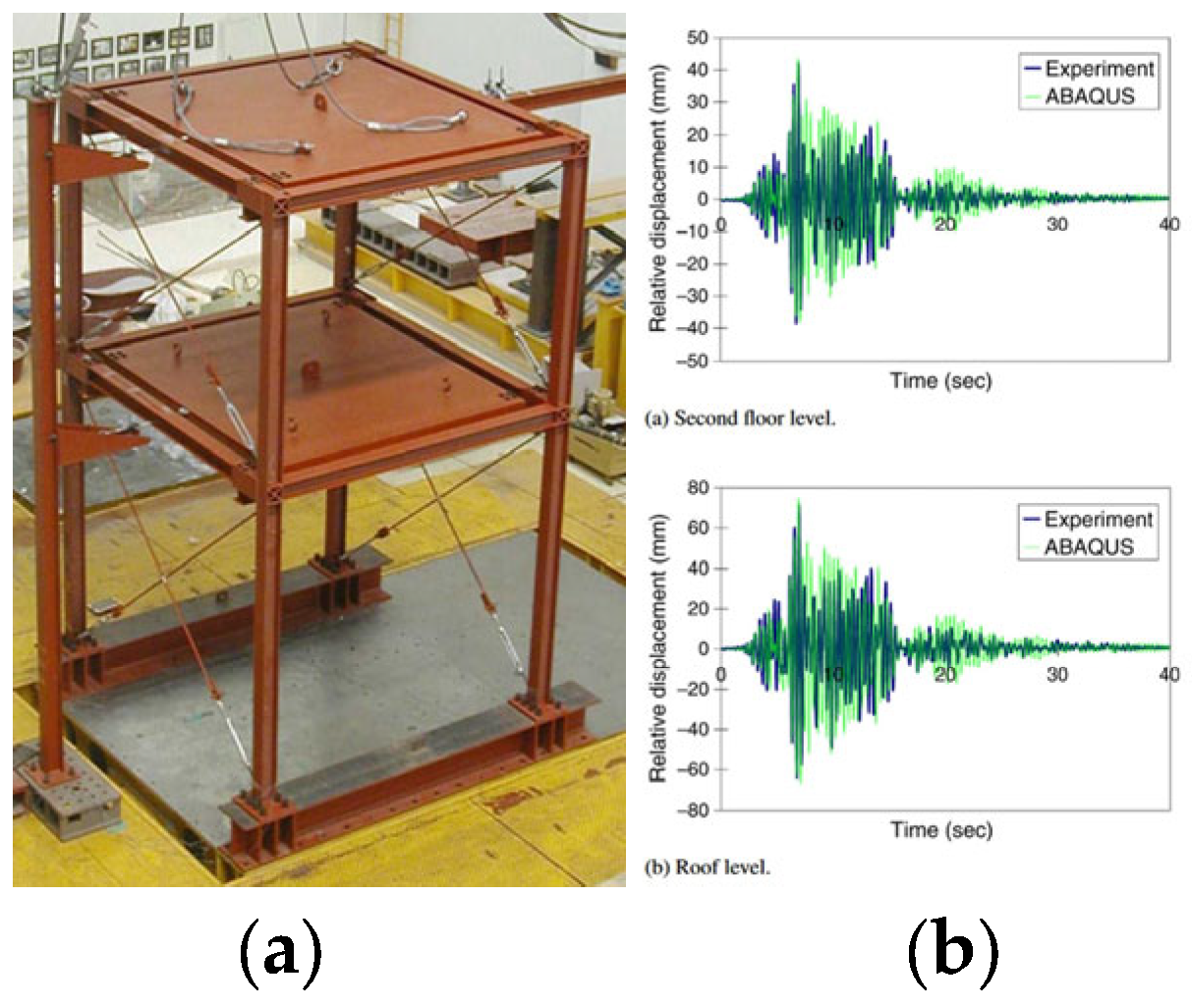



Disclaimer/Publisher’s Note: The statements, opinions and data contained in all publications are solely those of the individual author(s) and contributor(s) and not of MDPI and/or the editor(s). MDPI and/or the editor(s) disclaim responsibility for any injury to people or property resulting from any ideas, methods, instructions or products referred to in the content. |
© 2025 by the authors. Licensee MDPI, Basel, Switzerland. This article is an open access article distributed under the terms and conditions of the Creative Commons Attribution (CC BY) license (https://creativecommons.org/licenses/by/4.0/).
Share and Cite
Kan, Y.; Rong, X.; Zhang, J. Shaking Table Test Research on Novel Frame Structures: A Review. Buildings 2025, 15, 1368. https://doi.org/10.3390/buildings15081368
Kan Y, Rong X, Zhang J. Shaking Table Test Research on Novel Frame Structures: A Review. Buildings. 2025; 15(8):1368. https://doi.org/10.3390/buildings15081368
Chicago/Turabian StyleKan, Yiwen, Xian Rong, and Jianxin Zhang. 2025. "Shaking Table Test Research on Novel Frame Structures: A Review" Buildings 15, no. 8: 1368. https://doi.org/10.3390/buildings15081368
APA StyleKan, Y., Rong, X., & Zhang, J. (2025). Shaking Table Test Research on Novel Frame Structures: A Review. Buildings, 15(8), 1368. https://doi.org/10.3390/buildings15081368





